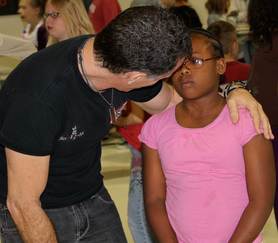|
Every day thousands of young people experience bullying from their peers while at school, after school in their neighborhoods, and even when they are at home, through social media and texts. We have created many resources to help Educators and parents to help facilitate a conversation about bullying and ways to prevent bullying along with offering proven strategies to help kids dealing with bullies. Tips for ParentsIf you are a parent, you may not be aware that your child is being bullied. Many kids are afraid to let an adult know what's happening. They feel embarrassed and think they have to handle the situation on their own. Have you noticed any of the following signs in your child?
Here's what you can do if your child is being bullied: 1. Talk with your child, letting him or her know that you understand and care. 2. Get in touch with your child's teacher or with school officials to inform them of the situation. Do this after school, by phone, or in a letter to protect your child's privacy and to make sure the bully or other kids don ’t find out. Keep written accounts of the bullying incidents and the times when you've talked with school staff members about the problem. 3. Teach your child the skills needed to resolve a bully situation such as being verbally assertive and having the confidence to seek the help of an adult. If you suspect that your child is the one doing the bullying, try some of these options: 1. Talk to your child about the reasons behind the bullying. Reassure your child that you still love him or her. 2. Consider family counseling to determine the cause of the problem. Your child may need help learning to manage anger and to resolve conflicts peacefully. 3. Help your child understand the differences between aggressive and assertive behaviors. 4. Let your child’s teacher know that your child is trying to stop bullying. The teacher may be helpful in setting goals and correcting bad behavior. Tips for EducatorsIf you are an educator, you can take steps to curb bullying in your classroom and beyond:
1. Find out how common bullying is in your school. Create and distribute an anonymous questionnaire, or talk privately with other teachers, your students, and their parents. 2. Set firm rules against bullying in your classroom. 3. Be aware of incidents of aggression that take place in the bathrooms, on the playground, in the lunchroom, and in the hallways. Monitor these areas to ensure a safer school environment. 4. Keep a written record of bullying incidents, including names, dates, times, and circumstances. Submit the reports to the principal. 5. Give students a chance to talk about bullying and its effects. Hold workshops or class discussions. 6. Get administrators and parents involved in reinforcing good behavior and supporting victims of bullying.
0 Comments
Leave a Reply. |
Author"The place where I grow ideas and create stories using words, illustrations and photographs." - Trevor Romain Categories
All
Archives
March 2023
|
|
|
Vertical Divider
|
|
© COPYRIGHT 2022 THE TREVOR ROMAIN COMPANY. ALL RIGHTS RESERVED.




 RSS Feed
RSS Feed